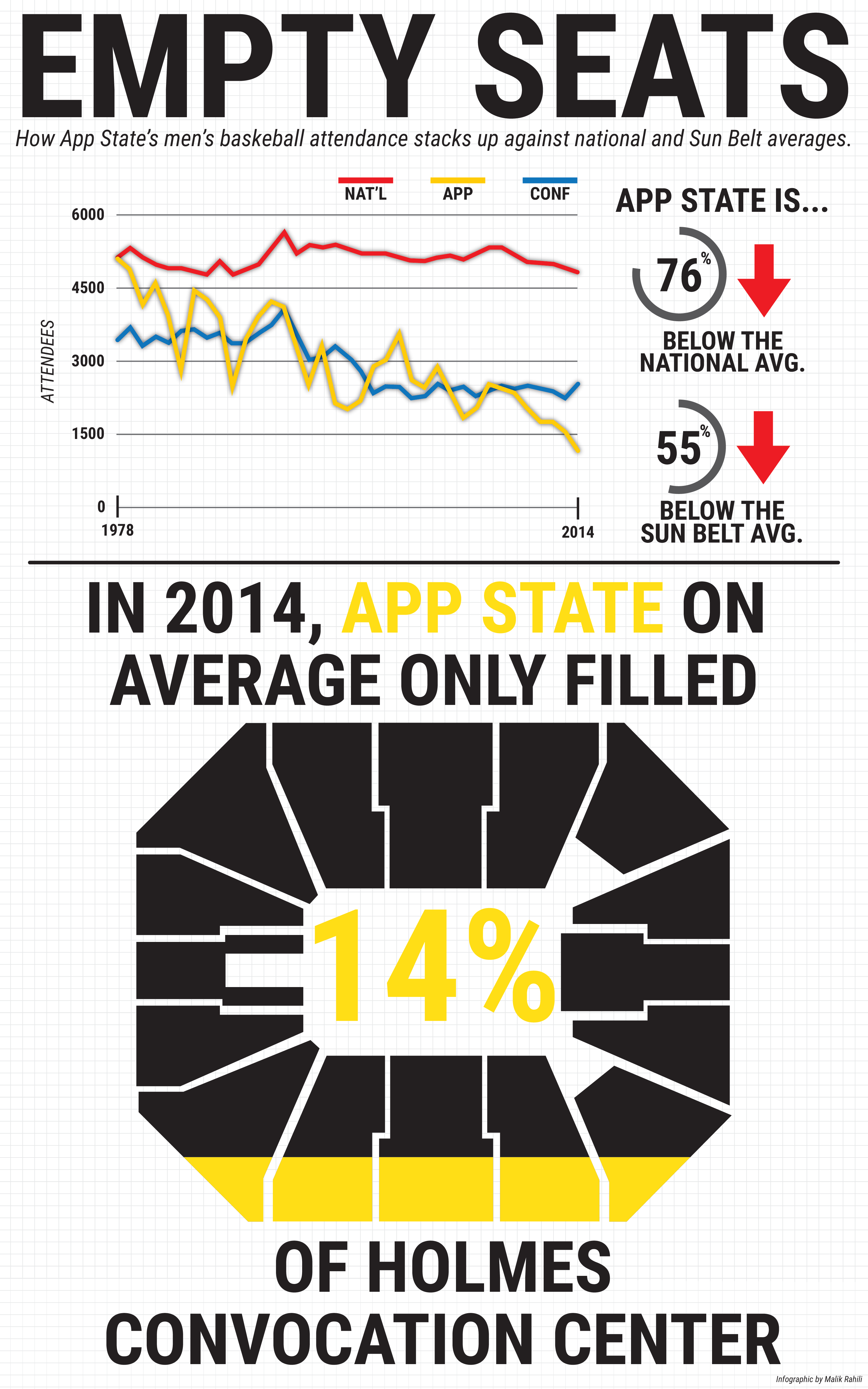Echoes. Come to an Appalachian State Basketball game at the Holmes Convocation Center and that’s what you’ll hear. The echo of the ball bouncing, players yelling and the refs whistling. Not the roars, gasps, chants and boos that are typically associated with college basketball. Just echos.
Appalachian State University is the proud owner of college basketball’s 140th largest gymnasium, able to hold a respectable 8,325 people. For comparison, Duke University’s Cameron Indoor Stadium holds 9,314, just under a 1,000 more than Holmes.
Duke has recorded a sell out for every single basketball game they’ve played this season, meaning that all 9,314 seats were filled, and that includes games against little-known schools like Siena and Bryant.
Appalachian State on the other hand hasn’t had a sell out in the Holmes Convocation Center since 2000, when UNC Chapel Hill came to Boone for the first ever game at Holmes.
While it is ridiculous to even begin to compare Appalachian State and Duke’s basketball programs, it isn’t ridiculous to use Duke as the shining example of attendance, especially in comparison to a school whose average attendance at home games has only been above the conference average one time since the 2004-05 season, with that lone occurrence coming in 2007-08 campaign.
A lot of people will point towards the programs lack of recent success as the main reason for the low attendance, but the program experienced five winning seasons during the last decade, including a 25-8 campaign during the 2006-07 season, good for the highest win total in school history. Appalachian State actually won the regular season conference title four times during the last decade — the 02-03,06-07,07-08 and 09-10 seasons.
While the on-court product has dropped off recently, with the program not recording a winning season since the 2010-11 campaign, it still doesn’t explain the overall poor attendance since the turn of the century.
The move to the Sun Belt Conference, along with a poor record the past two seasons, might explain the recent decline in attendance, but it still doesn’t account for the overall trend that has developed in the last 15 years.
College basketball teams rely on the home crowd to produce the coveted home court advantage and to help bring the energy. There’s a reason that teams like Kansas and Duke rarely lose home games, and it definitely goes beyond talent.
Players and coaches are aware of this, and they know how hard it is to win on the road compared to at home, but for Appalachian State, playing at Holmes might as well be like playing on the road with the lack of crowd noise and energy.
Houston Fancher, now an assistant under Mark Price at UNC Charlotte, was the head coach of the Mountaineers for nine seasons from 2000-09. Fancher acknowledged the difficulty of playing in what feels like an empty gym, and how his players suffered because of it.
“We had to create our own atmosphere at home and you should never have to do that in your own gym,” Fancher said. “I remember a couple times coming out to warm up and it felt like my wife and our friends were the only ones there.”
When current head coach Jim Fox first arrived in Boone in the spring of 2014, improving attendance was one of his goals.
“For the people in Boone, the season ticket holders, the alums, the boosters, everyone listening on the radio and everyone watching on App State TV, I need your help,” Fox said during his introductory press conference nearly two years ago. “I need you all to get behind us. I want to be the mayor of Boone by the time September rolls around.”
Needless to say that never happened, as the average attendance for home games during Fox’s first season was a paltry 1,130, more than 1400 less than the Sun Belt average.
Despite his team going 12-17 and being ineligible for postseason play, the blame can’t all be put on Fox, just like it can’t all be put on Fancher during his time here, or former coaches Buzz Peterson and Jason Capel.
The one group of people who can share the blame are the students. At Appalachian State University, any student with a valid AppCard is able to receive free admission into any home sporting event, and get their choice of seats at places like the Holmes Center.
While alumni aren’t exactly coming out in droves themselves, it is the students who are expected to cheer the loudest, show the most support and be at all the games. In a town with little to offer recreationally in the winter and a school with a beautiful gym that doesn’t have a bad seat in the entire building, where is everyone?
Some students will say that they don’t want to go watch a losing program, and while that may be the case, the team isn’t ever going to get any better without the support of the school’s students. Fox admitted to as much during his introductory press conference.
“I need the students,” Fox said. “I want to get out to the cafeteria and go to the fraternity houses. I want to go to the sorority houses. I want to meet as many people as possible. I want to get those students excited about our program. I told our players that I need them to get out there and get people excited about our program.”
It takes more than talent and coaching to build a winning program. Good recruits don’t want to come play in an empty gym, and players might not always give their all when there’s no one to see them do it. But that’s the case when the only noises to be found in the gym are echoes.
Story by: Lee Sanderlin, Associate Sports Editor
Infographic by: Malik Rahili, Editor-in-Chief


